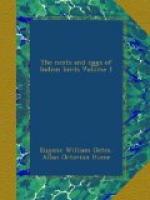Mr. R.M. Adam remarks:—“I had a nest brought me in Oudh on the 17th April, containing four eggs. About Agra and Muttra, where as you know the birds are very common, I have always obtained the greatest number of eggs during August; four is the regular number; in one taken on the 16th August I found five eggs.”
Mr. W. Blewitt writes:—“During July, August, and the early part of September I found multitudes of nests of this species in the neighbourhood of Hausie, almost exclusively in the Dhasapoor, Dhana, and Secundapoor Beerhs or jungle-preserves.
“The nests, of which numerous specimens were sent to you, were of the usual type, and were nearly all found in ber (Z. jujuba) and hinse (Capparis aphylla) bushes, at heights of from 3 to 4 feet from the ground. I did not meet with more than four eggs in any one nest.”
Colonel E.A. Butler says:—“The Indian Wren-Warbler is very common in the plains, frequenting low scrub-jungle and long grass studied with low bushes (Calotropis, Zizyphus, &c.). It breeds during the monsoon, commencing to build in July, during which month and August in the neighbourhood of Deesa I must have examined some three or four dozen nests. There are two distinct types of nests, and there may be two species of this genus in this part of the country; but I must confess that after shooting a large number of specimens of both sexes, and after examining an immense series of the eggs, I have failed to make out more than one species, and that Mr. Hume informs me is his Drymoipus terricolor. The nests alluded to vary as follows:—One type is very closely and compactly woven, as described of D. terricolor (’Nests and Eggs, Rough Draft,’ p. 349), with the entrance almost at the top. The other type is built of the same material, with the exception that the grass is rather coarser, but is more in shape like a Wren’s nest, and the grass is somewhat loosely put together instead of being woven, and it has the entrance with a slight canopy over it upon one side. The eggs four, and not uncommonly five, in number, were exactly alike in both types, as also were the specimens of the birds themselves that I obtained.
“Nearly all the nests I have seen have been built on the outside of ber bushes (Z. jujuba), at heights varying from 21/2 to 5 feet from the ground.”
Mr. B. Aitken says:—“I found this nest at Bombay on the 13th October, 1873, at the edge of a tank some 2 feet above the ground. I have found four or five precisely similar ones before, generally in similar situations. The nest was strongly attached to the stems and leaves of four herbaceous plants growing close together. In many cases the strips of grass had been passed through and pierced the leaves. The nest is deep and purse-shaped; the sides were prolonged upwards, except in front where the entrance was, and joined above so as to form a canopy. The nest has no lining,




